Jicarilla Apache Polychrome Cylindrical Lidded Basket - 25869
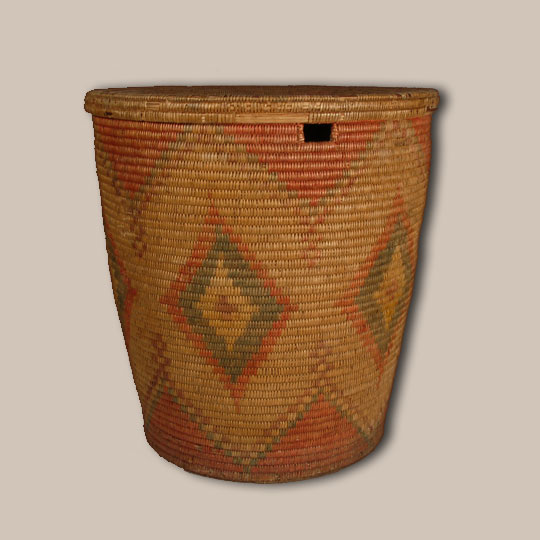 The Jicarilla Apache Reservation is located in the northern part of central New Mexico. The name Jicarilla comes from the Spanish word for "little basket."When the Spanish arrived, in what is now New Mexico, they were impressed by the small pitch-covered baskets which the Jicarilla used for holding drinking water. These small baskets were tightly woven and covered with piñon pitch to make them waterproof. Fine basket weaving had been a Jicarilla tradition for centuries but the quality and beauty of the baskets was not well-recognized until the 1950s, when traders of the area began to enter the baskets in the Gallup Inter-tribal Indian Ceremonial.
The Jicarilla Apache Reservation is located in the northern part of central New Mexico. The name Jicarilla comes from the Spanish word for "little basket."When the Spanish arrived, in what is now New Mexico, they were impressed by the small pitch-covered baskets which the Jicarilla used for holding drinking water. These small baskets were tightly woven and covered with piñon pitch to make them waterproof. Fine basket weaving had been a Jicarilla tradition for centuries but the quality and beauty of the baskets was not well-recognized until the 1950s, when traders of the area began to enter the baskets in the Gallup Inter-tribal Indian Ceremonial.
Kiowa Peyote Ceremony Painting by Alfred Momaday - 25870
Al Momaday is as well-known as a teacher and educator as he is an artist. He was of the Kiowa Tribe but spent 20 years as a principal and teacher at the Jemez Pueblo Day School. He lived in New Mexico from 1947 until he passed away at Jemez Springs in 1981. He was the son of A-ho and Mammedaty (Standing High) and the father of Pulitzer Prize-winning author N. Scott Momaday. He was married to author and poet Natachee Scott Momaday who was of Kiowa and Cherokee heritage.
Nine-piece Cochiti Pueblo Nacimiento - Nativity by Ramus Suina - C3702D
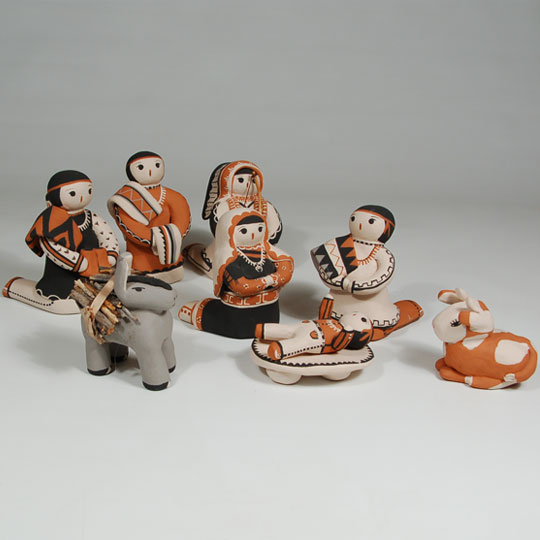 In this 9-piece nacimiento - nativity scene, Mary and Joseph are kneeling by the Christ Child resting on a cradleboard. Mary has a shawl over her head and she is wearing a traditional pueblo dress with a sash around her waist. Joseph wears a traditional pueblo shirt and has a blanket tossed over a shoulder. The Christ Child is dressed in a button up shirt and trousers with pockets and he has a necklace. The set is signed Spotted Fawn '87 R.R.S. Cochiti Pueblo, N.M.
In this 9-piece nacimiento - nativity scene, Mary and Joseph are kneeling by the Christ Child resting on a cradleboard. Mary has a shawl over her head and she is wearing a traditional pueblo dress with a sash around her waist. Joseph wears a traditional pueblo shirt and has a blanket tossed over a shoulder. The Christ Child is dressed in a button up shirt and trousers with pockets and he has a necklace. The set is signed Spotted Fawn '87 R.R.S. Cochiti Pueblo, N.M.
Hopi Pueblo Sio Hemis Katsina Doll by Jimmy Koots - 25771
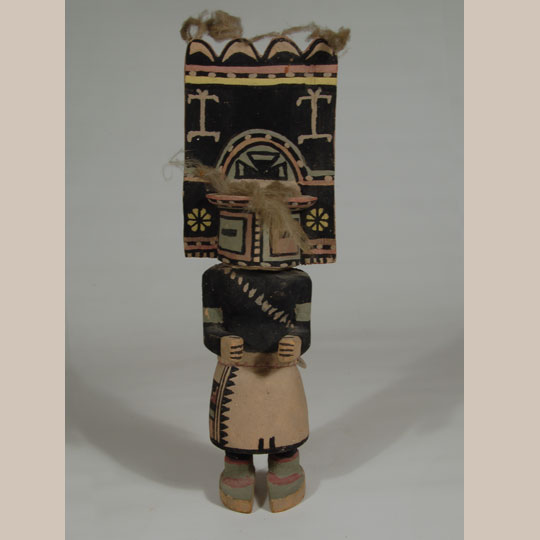 The Hemis and Sio Hemis Katsinas are probably the most beautiful and best known of all Hopi Katsinas. Their elaborate headdress, called a tableta, is partly responsible for their attraction. They both wear a kilt, and around the waist a Hopi embroidered rain sash.
The Hemis and Sio Hemis Katsinas are probably the most beautiful and best known of all Hopi Katsinas. Their elaborate headdress, called a tableta, is partly responsible for their attraction. They both wear a kilt, and around the waist a Hopi embroidered rain sash.
The Sio Hemis Katsina is an import at Hopi from Zuni Pueblo probably in the 1890s. He may substitute for the traditional Hopi Hemis during the Niman Ceremony of mid-July. There is very little difference between the Hemis and Sio Hemis except for the decoration of the tableta. The Hopi Hemis has towering clouds and rain depicted on the tableta, while the Sio Hemis has dragonflies and sunflowers with smaller clouds at the top.
Szwedzicki Print of a Historic Cochiti Bowl - 25772B
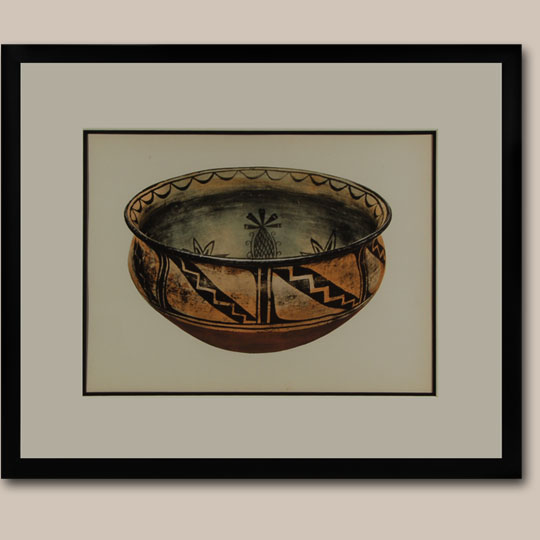 In 1933, C. Szwedzicki of Nice, France, published a set of 50 pottery images in color from specimens in the collection of the Indian Arts Fund of Santa Fe, New Mexico. This group was issued as Volume I of several volumes to be published later on other subjects. Only 750 copies of this volume were printed. The portfolio was titledPueblo Indian Pottery. The 50 individual plates of pottery from nine pueblos were combined with a booklet and encased in a hard bound folio.
In 1933, C. Szwedzicki of Nice, France, published a set of 50 pottery images in color from specimens in the collection of the Indian Arts Fund of Santa Fe, New Mexico. This group was issued as Volume I of several volumes to be published later on other subjects. Only 750 copies of this volume were printed. The portfolio was titledPueblo Indian Pottery. The 50 individual plates of pottery from nine pueblos were combined with a booklet and encased in a hard bound folio.
Szwedzicki Print of a Historic Tesuque Jar - 25772A
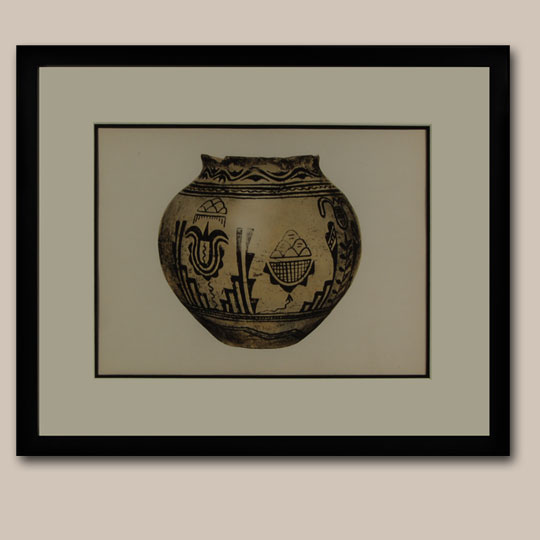 In 1933, C. Szwedzicki of Nice, France, published a set of 50 pottery images in color from specimens in the collection of the Indian Arts Fund of Santa Fe, New Mexico. This group was issued as Volume I of several volumes to be published later on other subjects. Only 750 copies of this volume were printed. The portfolio was titled Pueblo Indian Pottery. The 50 individual plates of pottery from nine pueblos were combined with a booklet and encased in a hard bound folio.
In 1933, C. Szwedzicki of Nice, France, published a set of 50 pottery images in color from specimens in the collection of the Indian Arts Fund of Santa Fe, New Mexico. This group was issued as Volume I of several volumes to be published later on other subjects. Only 750 copies of this volume were printed. The portfolio was titled Pueblo Indian Pottery. The 50 individual plates of pottery from nine pueblos were combined with a booklet and encased in a hard bound folio.
Historic Cochiti Pueblo small Decorated Bowl - C3644B
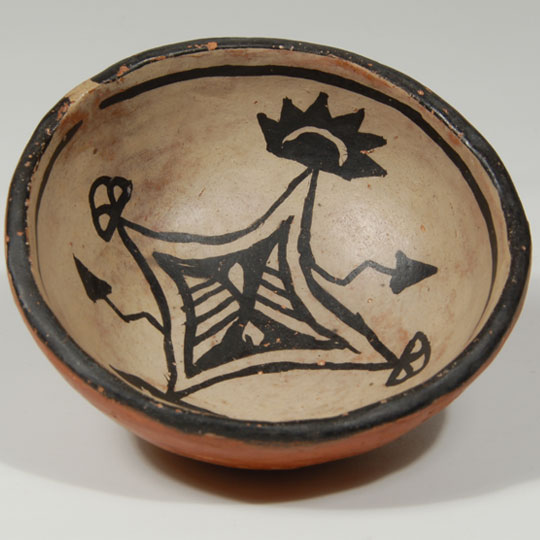 This is a small Southwest Indian Pottery bowl from Cochiti Pueblo. The interior of the historic bowl is covered in cream slip over which was painted a design in black. The main design is typical of Cochiti designs, floating independently inside the bowl representing lightning, clouds and the sun. Two black bands decorate the top of the bowl, one at the very top and a thinner band about a half an inch down. The exterior of the bowl was covered with a red slip. There is no obvious indication that this bowl has been used.
This is a small Southwest Indian Pottery bowl from Cochiti Pueblo. The interior of the historic bowl is covered in cream slip over which was painted a design in black. The main design is typical of Cochiti designs, floating independently inside the bowl representing lightning, clouds and the sun. Two black bands decorate the top of the bowl, one at the very top and a thinner band about a half an inch down. The exterior of the bowl was covered with a red slip. There is no obvious indication that this bowl has been used.
Original Painting of a Kiowa Eagle Dancer by Woodrow "Woody" Wilson - C3514.14
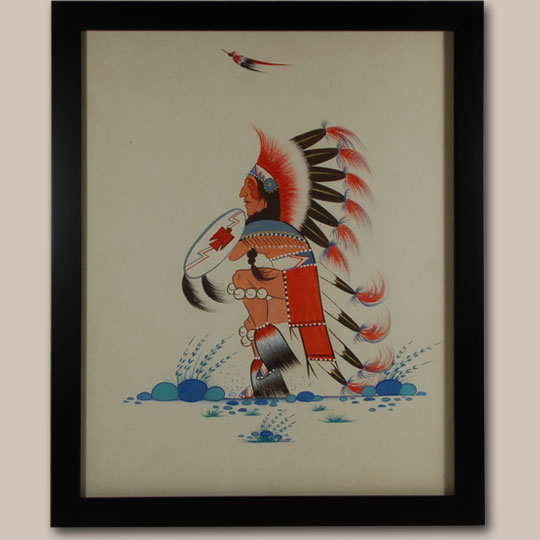 Kiowa artist and grandson of a Kiowa chief, Woodrow Wilson "Woody" Big Bow was born in Carnegie, Oklahoma, on January 29, 1914. As a teenager he attended classes at the University of Oklahoma at Norman, where, under the personal guidance of Oscar B. Jacobson, he took advantage of the opportunity to receive instruction in painting. He was one of several young Kiowa artists at the university whose work was featured in exhibitions in Europe and subsequently published in folio editions of American Indian art, the first of their kind ever issued.
Kiowa artist and grandson of a Kiowa chief, Woodrow Wilson "Woody" Big Bow was born in Carnegie, Oklahoma, on January 29, 1914. As a teenager he attended classes at the University of Oklahoma at Norman, where, under the personal guidance of Oscar B. Jacobson, he took advantage of the opportunity to receive instruction in painting. He was one of several young Kiowa artists at the university whose work was featured in exhibitions in Europe and subsequently published in folio editions of American Indian art, the first of their kind ever issued.
Multi-story Taos Pueblo and Landscape Scene by Albert Lujan - C3695B
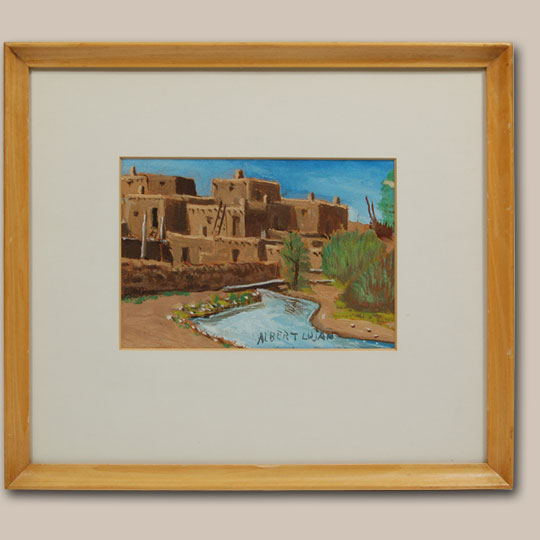 Albert Lujan (1892-1948) Weasel Arrow, an early Taos Pueblo painter, was ahead of his time in painting European-American style art rather than the Dorothy Dunn School of art being practiced by most of the other Native American artists of his time. His work was shunned by collectors and the Museum of New Mexico Fine Art Gallery because it was too much like that which the Taos and Santa Fe artists produced. Now he has come of age. His works are being sought by collectors and museums.
Albert Lujan (1892-1948) Weasel Arrow, an early Taos Pueblo painter, was ahead of his time in painting European-American style art rather than the Dorothy Dunn School of art being practiced by most of the other Native American artists of his time. His work was shunned by collectors and the Museum of New Mexico Fine Art Gallery because it was too much like that which the Taos and Santa Fe artists produced. Now he has come of age. His works are being sought by collectors and museums.
Original Painting of Abstract Circular Form by Tony Da - C3700
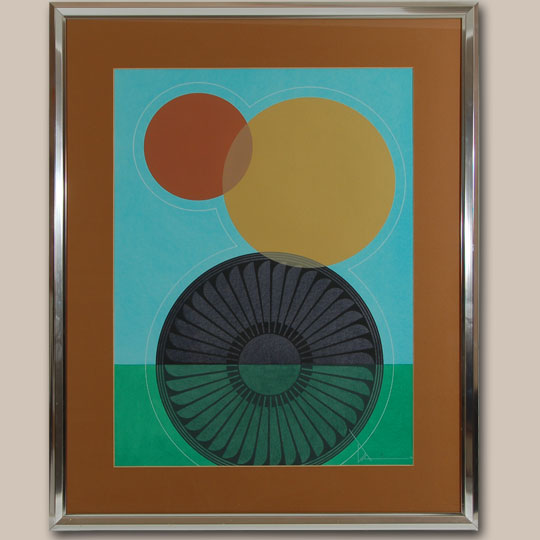 Tony Da (1940-2008) Anthony Edward Da was a painter before becoming a potter. His earliest paintings appear to be from 1957, the year before he graduated from High School. He continued painting until 1966 when he moved in to live with his grandmother, Maria Martinez. At that time, Maria began teaching him the rudiments of pottery making and he developed into an accomplished potter in less than three years and his painting career slowed dramatically at that time. He made pottery on a full-time basis and painted only occasionally.
Tony Da (1940-2008) Anthony Edward Da was a painter before becoming a potter. His earliest paintings appear to be from 1957, the year before he graduated from High School. He continued painting until 1966 when he moved in to live with his grandmother, Maria Martinez. At that time, Maria began teaching him the rudiments of pottery making and he developed into an accomplished potter in less than three years and his painting career slowed dramatically at that time. He made pottery on a full-time basis and painted only occasionally.
Zuni Pueblo Channel Inlay Thunderbird Concha Belt - C3696A
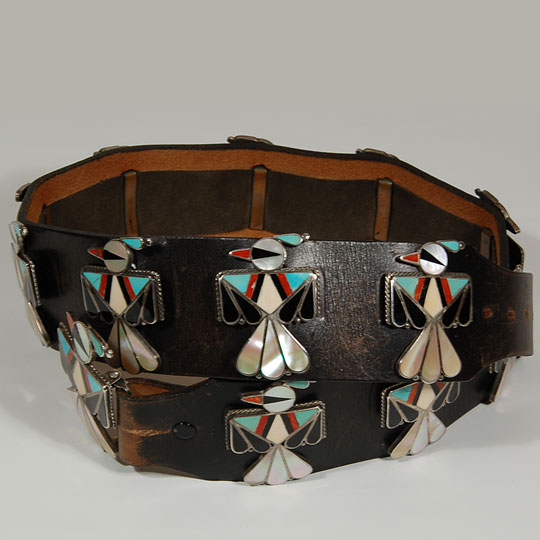 This belt consists of 12 Thunderbird-style conchas, each comprised of channel inlay of mother of pearl, jet, turquoise, coral, bone and sterling silver. Each bird measures 2-1/4" x 1-5/8". A buckle of the same style measures 2-3/4" x 1-7/8". The leather belt measures 2-1/4" wide. There is no maker's mark on the Zuni Pueblo buckle or conchas.
This belt consists of 12 Thunderbird-style conchas, each comprised of channel inlay of mother of pearl, jet, turquoise, coral, bone and sterling silver. Each bird measures 2-1/4" x 1-5/8". A buckle of the same style measures 2-3/4" x 1-7/8". The leather belt measures 2-1/4" wide. There is no maker's mark on the Zuni Pueblo buckle or conchas.
Navajo Silver and Turquoise Cluster Ring - C3696C
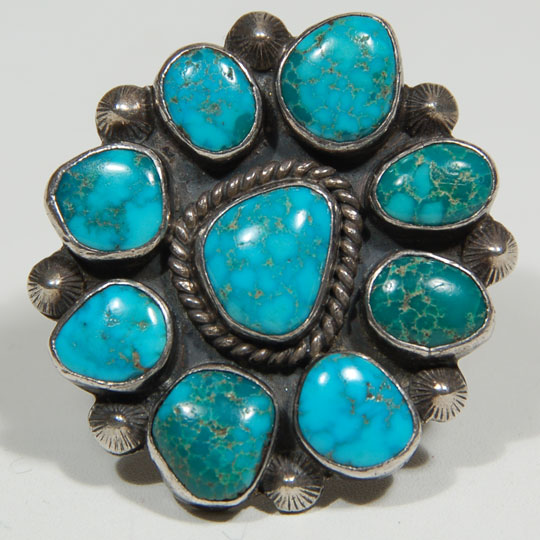 Navajo jewelers are skilled in using elegant silver settings to highlight the beauty of turquoise stones. This cluster ring has eight high-grade turquoise stones surrounding a larger middle stone. The depth and color of the stones are the focal points of the ring.
Navajo jewelers are skilled in using elegant silver settings to highlight the beauty of turquoise stones. This cluster ring has eight high-grade turquoise stones surrounding a larger middle stone. The depth and color of the stones are the focal points of the ring.
Tewa Pueblo Ram Dancer Painting by Pablita Velarde - C3699B
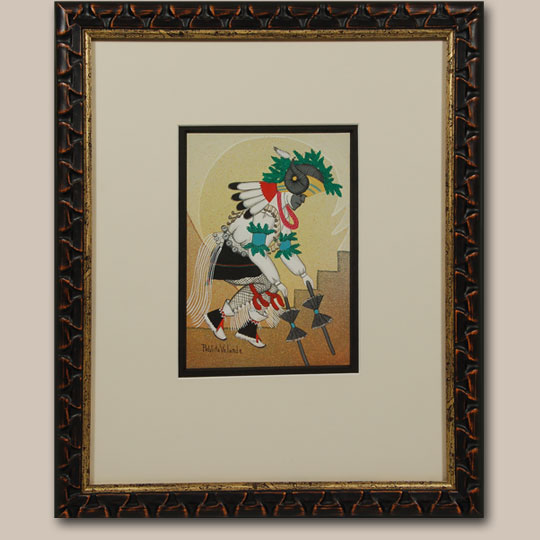 Pablita Velarde (1918-2006) Tse Tsan - Golden Dawn was well familiar with dance costume details and she was careful to portray dancers with accurate clothing. Her paintings are ethnographically important as well as artistically important. She has provided us with a detailed representation of pueblo dancers of her time.
Pablita Velarde (1918-2006) Tse Tsan - Golden Dawn was well familiar with dance costume details and she was careful to portray dancers with accurate clothing. Her paintings are ethnographically important as well as artistically important. She has provided us with a detailed representation of pueblo dancers of her time.
Pueblo dances are a lure for visitors to the Southwest. One must remember that these are not performed to entertain the visitors but are performed because they are a part of a religious ceremony. The Pueblo Indian feels he is an important part of nature and the universe and that he must be in balance with nature and the universe. Ceremonial dances are part of achieving that balance. Such dances always have a purpose, a function, whether it be for rain, snow, game animals, crops or other good things in life.
Pair of Paintings of Navajo Feather Dancers by Harrison Begay - C3791D
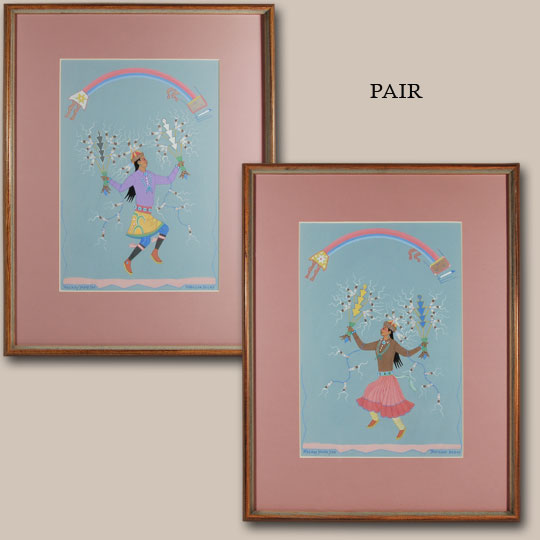 Harrison Begay was perhaps the most well-known Navajo painter of his generation. As a student of Dorothy Dunn's at the Santa Fe Indian School, Begay learned how to paint in the "Studio Style" (or "flat style") for which he would eventually become world-renowned. He and his classmates-Quincy Tahoma and Gerald Nailor among them-were encouraged to depict religious ceremonies and cultural rituals using a simple but effective set of tools: bold, opaque watercolors.
Harrison Begay was perhaps the most well-known Navajo painter of his generation. As a student of Dorothy Dunn's at the Santa Fe Indian School, Begay learned how to paint in the "Studio Style" (or "flat style") for which he would eventually become world-renowned. He and his classmates-Quincy Tahoma and Gerald Nailor among them-were encouraged to depict religious ceremonies and cultural rituals using a simple but effective set of tools: bold, opaque watercolors.
Horse Fetish Necklace “Wind Spirit” by Robert Kaniatobe - C3794
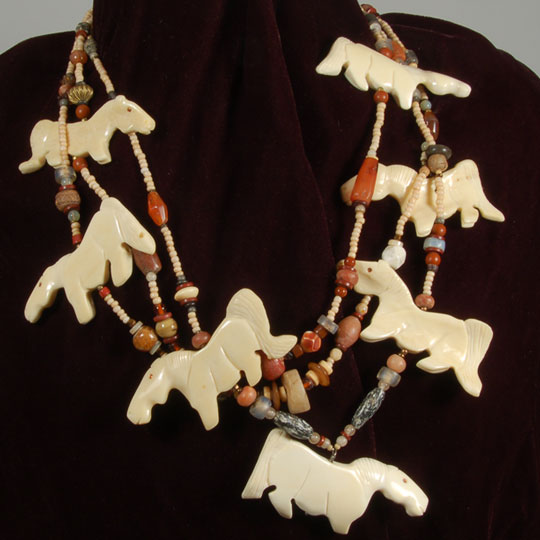 Robert Kaniatobe (1936-1998), Choctaw Tribe, was well known for making marvelous necklaces comprised of a multitude of materials. This one focuses on horses carved from buffalo bone.
Robert Kaniatobe (1936-1998), Choctaw Tribe, was well known for making marvelous necklaces comprised of a multitude of materials. This one focuses on horses carved from buffalo bone.
This necklace consists of three strands of small white pearl-color beads, ancient (1,000-years old) hand carved agate and granite, clay, shell, bone, burinut, brass, copper and sterling silver. Also included are early (circa 1600s) glass and milk glass, ancient green lined glass and sandcast glass, and Picasso glass beads from the 1940s. The horses were carved from buffalo bone and have brass eyes. Each of the seven horses is detailed with carving on front and back.
Historic Kewa (Santo Domingo) Pueblo Large Dough Bowl - C3753.37
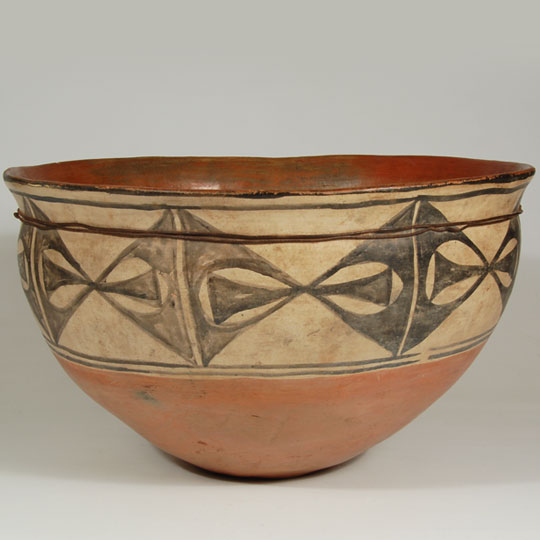 Generally, one considers large bowls that measure 18 or more inches in diameter to be classified as dough bowls. Bowls of lesser scale are often referred to as serving bowls, however, these smaller bowls, in the 14-inch diameter range, also may be considered dough bowls when they are being used as such.
Generally, one considers large bowls that measure 18 or more inches in diameter to be classified as dough bowls. Bowls of lesser scale are often referred to as serving bowls, however, these smaller bowls, in the 14-inch diameter range, also may be considered dough bowls when they are being used as such.
This bowl has sufficient depth and diameter to make bread for an average-sized family. The out-turned rim is another feature that is associated with dough bowls. Such a rim allows more room to accommodate a person's arms when kneading bread dough. A polished interior is another characteristic of dough bowls.
San Ildefonso Black and Sienna Candle Holder by Tse-Pé Gonzales - C3771C
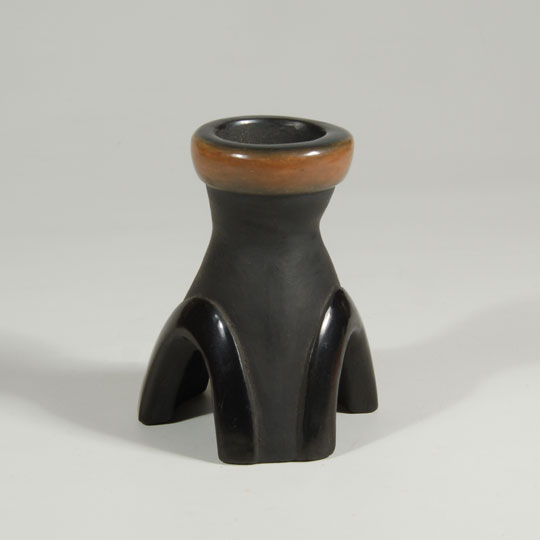 Tse-Pé is generally known by his singular name. His mother was Rose Gonzales, the potter who introduced carved blackware pottery to San Ildefonso Pueblo. Tse-Pé followed the tradition of carved pottery, but chose sgraffito carving rather than the deep carving of his mother's style. In the early 1970s, Tse-Pé was among the first potters to participate in the sgraffito movement, along with Tony Da, Popovi Da, Joseph Lonewolf, Art Cody and other male potters. Perhaps because pottery was traditionally a woman's craft, the sgraffito technique was adopted by males as a way not to produce woman's work.
Tse-Pé is generally known by his singular name. His mother was Rose Gonzales, the potter who introduced carved blackware pottery to San Ildefonso Pueblo. Tse-Pé followed the tradition of carved pottery, but chose sgraffito carving rather than the deep carving of his mother's style. In the early 1970s, Tse-Pé was among the first potters to participate in the sgraffito movement, along with Tony Da, Popovi Da, Joseph Lonewolf, Art Cody and other male potters. Perhaps because pottery was traditionally a woman's craft, the sgraffito technique was adopted by males as a way not to produce woman's work.
Historic Zuni Pueblo Small Jar in Drum Jar Design - 25727
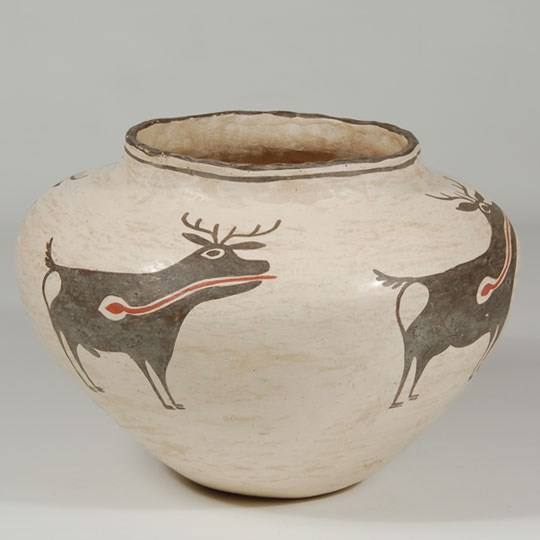 Zuni is the only pueblo known to have made pottery vessels for use as drums. Generally, they are 18 to 24 inches tall and 15 to 16 inches in diameter. The rim curves outward in a pronounced manner so as to form a ridge to secure a leather strap securely around the hide drum head that is stretched over the top of the pottery vessel. The vessel is slipped entirely in white slip and with only the minimal decoration-usually just four heartline deer.
Zuni is the only pueblo known to have made pottery vessels for use as drums. Generally, they are 18 to 24 inches tall and 15 to 16 inches in diameter. The rim curves outward in a pronounced manner so as to form a ridge to secure a leather strap securely around the hide drum head that is stretched over the top of the pottery vessel. The vessel is slipped entirely in white slip and with only the minimal decoration-usually just four heartline deer.
#adobegallery @Adobe Gallery #ZuniPuebloPottery
#SouthwestIndianPottery #ZuniPueblo #Historic
Zuni Pueblo Ceremonial-style Fetish Jar, circa 1930s by Teddy Weahkee - C3640
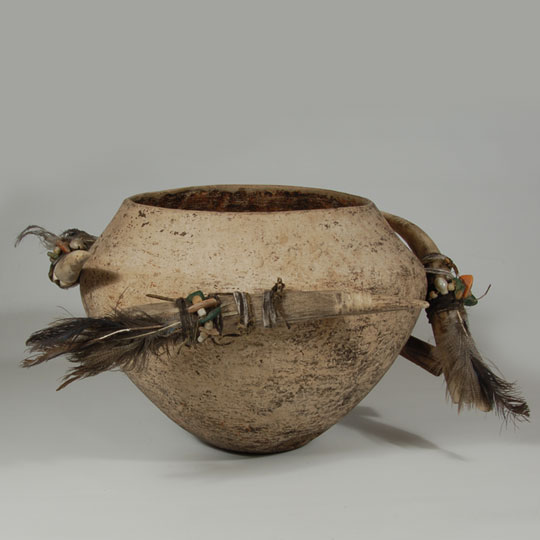 Fetishism is the worship of material things as the abodes of spirits, or more strictly, the belief that the possession and worship of an article can procure the services of a spirit lodged within it. The Zuni strongly believe in fetishes. To them a fetish is always potent, always holy and it can aid them when in their possession.
Fetishism is the worship of material things as the abodes of spirits, or more strictly, the belief that the possession and worship of an article can procure the services of a spirit lodged within it. The Zuni strongly believe in fetishes. To them a fetish is always potent, always holy and it can aid them when in their possession.
When not in need of having a fetish in their possession, the Zuni nevertheless provides for it in a manner of respect. A pottery jar is provided for storage of a fetish and for providing proper care of it. Fetishes are ceremonially fed when not in use. Food from the table is sometimes used but sacred corn meal is most often given. In performing the rite of feeding, the food is placed in a dish or on a piece of paper, and laid beside the fetish or the jar in which the fetish is kept. The food is left for 30 minutes or less in which time it is supposed to nourish the spirit of the fetish, after which the food is buried or thrown into the river. It is never burned or just thrown away.
#adobegallery @adobegallery #ZuniPuebloPottery #TeddyWeahkee
#SouthwestIndianPottery
Yokuts Indian Bottleneck Jar Basket - C3642B
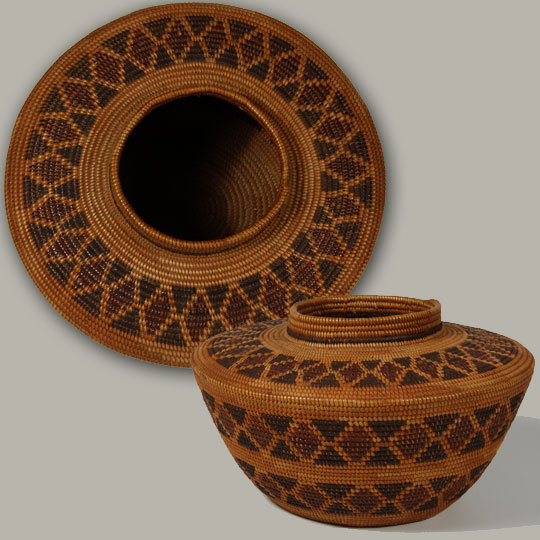 The Yokuts, whose members traditionally spoke the Yokutsan language lived in the central San Joaquin Valley region of California. Their territory stretched roughly from Stockton in the north down to Bakersfield in the south. They were formerly called the Tulare Indians by the Spanish settlers, meaning "people of the tules," tule being a type of marsh plant found in the shallow lakes and wetlands that once existed throughout traditional Yokuts territory. They were at one time a very large tribe with estimates of 25,000 to 35,000 people in 1772 when the Spanish first arrived in the area. Today their population has shrunk to a fraction of that number.
The Yokuts, whose members traditionally spoke the Yokutsan language lived in the central San Joaquin Valley region of California. Their territory stretched roughly from Stockton in the north down to Bakersfield in the south. They were formerly called the Tulare Indians by the Spanish settlers, meaning "people of the tules," tule being a type of marsh plant found in the shallow lakes and wetlands that once existed throughout traditional Yokuts territory. They were at one time a very large tribe with estimates of 25,000 to 35,000 people in 1772 when the Spanish first arrived in the area. Today their population has shrunk to a fraction of that number.
#adobegallery @Adobe Gallery #SouthwestIndianBasket #Yokuts

